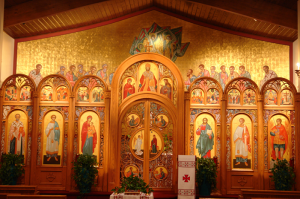 It was only in the fourteenth century that the altar area (i.e., sanctuary) came to be distinguished from the nave by what we now call the iconastasis. Earlier church buildings had a series of columns and or panels that served to distinguish and separate the nave from the sanctuary. Images representing Christ, Mary, angels and saints were attached to these columns or carved into these panels.
It was only in the fourteenth century that the altar area (i.e., sanctuary) came to be distinguished from the nave by what we now call the iconastasis. Earlier church buildings had a series of columns and or panels that served to distinguish and separate the nave from the sanctuary. Images representing Christ, Mary, angels and saints were attached to these columns or carved into these panels.
Two icons particularly associated with the altar area were Christ Pantocrator and the Virgin. Also popular was the deeis: Christ Pantocrator with the Virgin and John the Baptizer in supplication on either side.
This chancel (altar area) barrier began to be transformed in the fifteenth century into what is now regarded as the typical iconostasis. The icons of Christ and the Mother of God achieved a traditional position on the iconastasis, to the south and the north respectively of the Royal Doors. The Annunciation found a place on the Royal Doors, symbolizing the role of the Annunciation in salvation history. God’s incarnation has radically changed human history.
As one might guess, the Church then developed a whole understanding of the symbolism of the iconastasis. Although some see it as a separation of the altar area from the nave and a place where only ordained clergy can go, it has a much greater symbolism and truly supports the entire liturgical drama.
As we know, the various areas of the church building took on specific meaning. The vestibule symbolizes life before faith. The nave symbolizes the kingdom of God on earth. The altar area symbolizes the kingdom to come. Like the Temple of Israel, the altar area is seen as the Holy of Holies, the area symbolizing God’s heavenly kingdom and the place where God’s meets and interacts with His people (very similar to the Jewish Temple)
When we observe the movement of the Liturgy, we see that all things come from heaven into the world only to lead the faithful, symbolically, back to heaven. For example, the Word of God, the Gospel, is brought from heaven into the world in order to lead us symbolically back to heaven. The symbolism is that if we follow the teachings of Christ contained in the Gospels, we will be led back to heaven.
So too the entrance with the gifts of bread and wine, symbols of human life. They are brought, during the Great Entrance, from the area representing heaven into the world. But the procession does not stop in the nave. Rather, the gifts are then carried back into the altar area, heaven. All life is from God and, in the end, returns to God. Together with Jesus we offer thanks to God for the life that has been given us.
